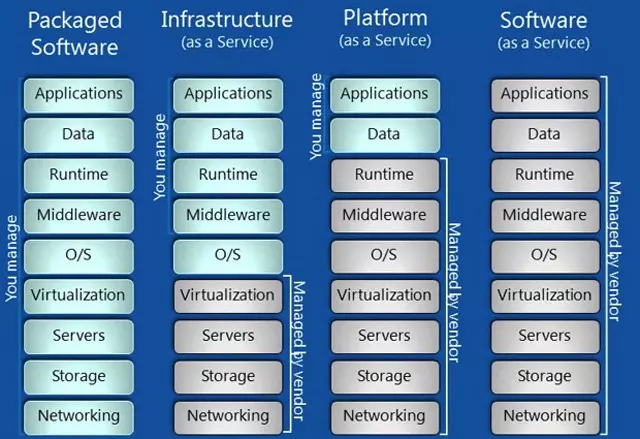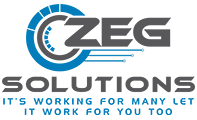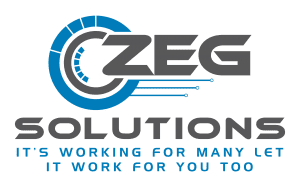Since the mass adoption of cloud computing services by service providers began some 15 years ago, the number of companies coming to realize the vast potential and thus entering the market has rapidly increased.
Cloud computing is an ever-present, on-demand network that grants you access to a shared space of resources. Whether it’s an application, a server, storage or other services, they can be provisioned with very efficient work and management.

Suppose you are eager to know more about cloud computing and how cloud computing services are different from cloud storage services. In that case, you may find it useful to read my post on “what’s the difference between cloud computing and cloud services.” In this post, I intend to share the main qualities available in 4 different types of cloud computing service models with you.
You can see Examples of cloud-based technology services and have a sense of it.
IaaS : Infrastructure-as-a-service
Infrastructure-as-a-service is one of the four types of cloud services. It is an instant computing infrastructure provisioned and managed over the internet. It can quickly scale up and down with the demand, so you won’t have to pay unless for what you use. It can help avoid all the troubles associated with the expenses and complexity of buying and managing physical servers and other data center infrastructure. Each resource is represented as a separate service component, so you only need to rent a particular one for as much time as you need it. While you purchase, install, configure, and manage your software, a cloud computing service provider’s job will be to manage the infrastructure.
A few main benefits of IaaS include increased performance and security, improved scalability and flexibility and better support for disaster recovery and business continuity.
You can also read more about IaaS here.
PaaS : platform-as-a-service
In platform-as-a-service, the service provider delivers a platform to its clients that enables them to develop, run and manage business applications without building and maintaining the infrastructure that software development processes typically require.
This model is similar to those concepts we see in serverless computing and function-as-a-service because PaaS architectures keep the underlying infrastructure out of sight of developers and other users.
Public-private or hybrid clouds are the spaces through which PaaS can be delivered. If the service is offered through a public cloud, it is the customer that will control software deployment. In contrast, the cloud provider delivers all the major IT components required to host the applications, including servers, storage systems and networks, operating systems and databases. PaaS will be delivered as software or an appliance within a customer’s fireball, typically in its on-premises datacentre, if the offering is through a private cloud.
One clear advantage of using PaaS can test and implement new applications deployed more quickly. This faster deployment can provide for better business success. Another benefit of PaaS that goes with most cloud services is dynamic scaling. When needing a more robust infrastructure, the provider will make it happen, scaling back whenever the demand is low, thus saving money overall.
You can also read more about PaaS here.
SaaS: software-as-a-service
The rise of the software-as-a-service model alongside cloud-based computing systems has helped large organizations deal with one of their main challenges. They previously had to purchase compact discs containing the updates for their systems and then download them onto their computers. This was a time-consuming process, especially for larger companies. Later on, software updates became available for download through the internet. Companies had to purchase additional licenses rather than additional discs, still needing a copy of the software installed on all devices that needed access to it.
With the help of SaaS, users won’t have to install or update any software anymore. It will be enough to connect to the service provider’s network to access the particular service they need.
SaaS is easy to implement and can be updated and debugged very merely. Since users pay for SaaS as they proceed and won’t have to purchase multiple software licenses for different computers, this model can be less expensive or may at least have lower up-front costs.
Among SaaS, numerous applications are email services, automating sign-up for products and services, auditing functions, managing documents (including file sharing and document collaboration) and shared company calendars for scheduling events.
You can also read more about SaaS here.
FaaS : Functions-as-a-service
Also known as serverless computing, this model allows the customer to execute code responsively without allocating processing resources ahead of time. Because the cloud provider will handle the infrastructure, the customer will be allowed to focus specifically on deploying the application code. Another advantage is that functions scale automatically. This makes them an excellent fit for dynamic workloads that vary in terms of resource consumption.
Deployment of most FaaS applications is effortless. The cloud customer will upload the complete function code and tell the platform how to provision resources at execution. The main disadvantage of FaaS might be the execution time. Functions need to provision resources each time they run, so there may be slight performance legs if the application requires a good deal of computing power or executes during peak usage times.
You can also read more about FaaS here.


